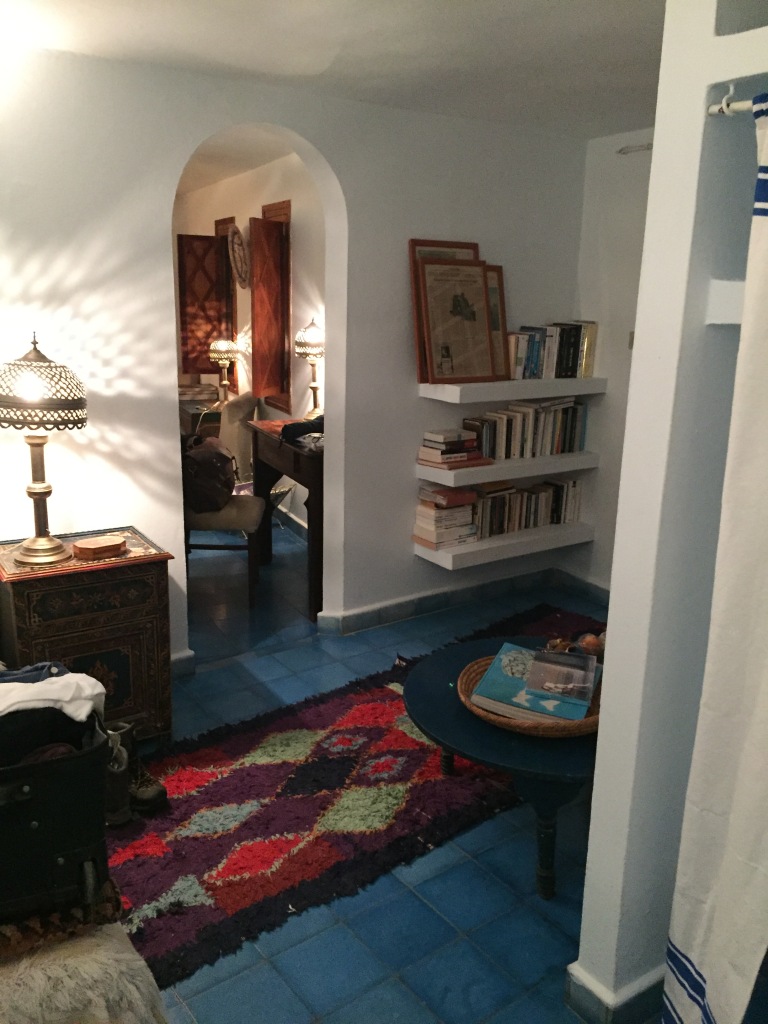
I thought I was prepared for Morocco. I wasn’t.
Morocco is 98% Muslim, mostly Sunni. Most of the women wear the hijab, a covering for their hair. Sometimes I see women wearing the burqua or niqab. Some women wear a hijab but also have a wide scarf (usually white or cream-colored) that they pull across their nose and mouth when in public.

I arrived in Tangier Sunday night. I stayed at Dar Nour (Tangier’s first guesthouse) situated on 11th century ramparts in the Kasbah where Tennessee Williams and the novelist Paul Bowles stayed sometimes during their visits. My room was spacious with windows that looked out toward the medina.



At 8 PM I heard the adhan, the Muslim call to prayer over the loudspeakers. It is loud and resounds all over Tangier for about seven or eight minutes. It doesn’t mean that people must begin praying immediately, but that the time slot for one of the five daily prayers has begun. Even so, I could hear people praying. It sounded like a collective moaning rising from all parts of the city.
Because I only had the following morning to see Tangier, I hired a guide. He met me at the guesthouse at 10 AM. It was raining hard and I wasn’t sure I wanted to go but I had an umbrella (and so did he) so off we went. I’m glad I did; the rains stopped about 15 minutes later and didn’t begin again until we were back at the guesthouse.

When Karim would show me a place of significance, he would finish by saying, “Take photo now.”
🙂
But some of those places were not interesting to actually look at. But who was I to argue? I snapped away. Consequently, I have pictures of walls, of doorways, of the bland sides of buildings and I can’t remember what they represent. I’ve deleted them.
He seemed to know everybody. Men were always acknowledged; women were ignored unless they were very old.
Making eye contact with women is a social taboo. Even so, I found it very difficult to avoid.






We returned to the guesthouse about 12:30 and I hurriedly packed. There are two kinds of taxis in Tangier — the grand taxis, which take you anywhere you want to go including other cities; and the petit taxis, which are hired for inside the city limits. I hired a grand taxi to drive me the hour and a half to the artists’ residency.
If I thought that Tangier surprised me, I had no idea what would be in store in the city of Tetouan, where I am now. There are almost no tourists. As I walk around the city, I am the only Caucasian I see. What surprises me is how little attention I attract. Sure, some people look at me but mostly they just go about their business.
But this is an experience unlike any other I’ve had in my travels. Stay tuned.

A man in a man”s world. Just think how different your experience would be if you were a woman. Thank God I was born in the USA and I pray it stays totally Western. I have no interest in seeing the rest of the what is left of freedom for women in the world to be lost. How sad you can’t even look at a woman there …. they mean nothing to them but property.
LikeLike
The plight of women in Muslim countries is complicated. And heartbreaking, too. I wouldn’t even be able to imagine what things are like for them. But oppression damages everyone, including the men. I think this gets overlooked in light of their privilege. Islam pervades everything — it’s coming out of the loudspeakers, it controls… well, the entire culture. I know there are good things in the religion, that’s always true. Moroccans are very proud of their long history of living in peace with their Christian and Jewish neighbors. I’m having trouble writing about it because this short period of time seems inadequate to address something so large. All I can do is tell my stories and observe what I think is true from my own experience.
It’s good to hear from you Sierra — I hope you’re getting settled into your new home.
LikeLike
I have fallen a bit behind on reading, Bart, so I am happy to see I am not missing the beginnings of your Morocco experience! I just learned a good Spanish word today for how this must be feeling to you: “ajeno” (ah-hay-no) = foreign, alien. I am guessing it may be exciting and disturbing at the same time (?). I can’t wait to hear more.
Safe and rich time to you there! 🙂
LikeLike